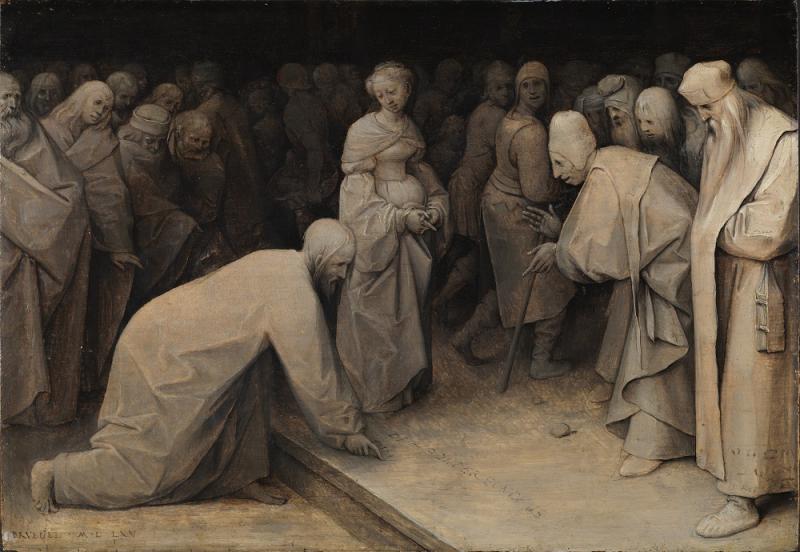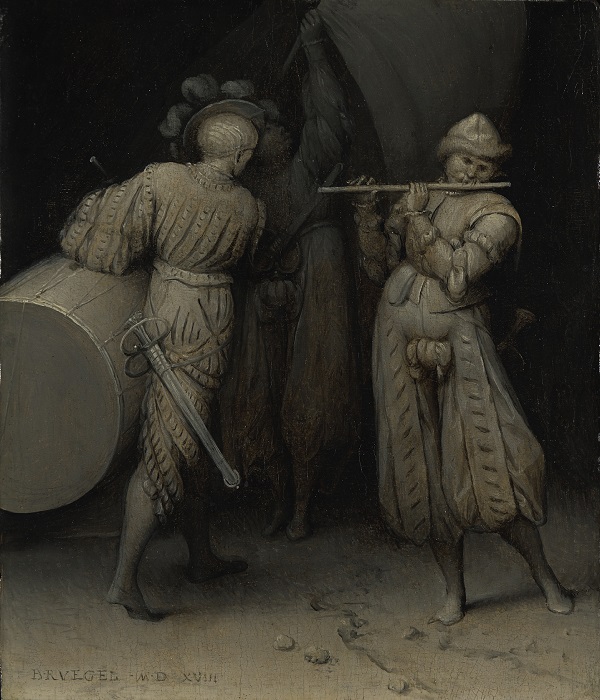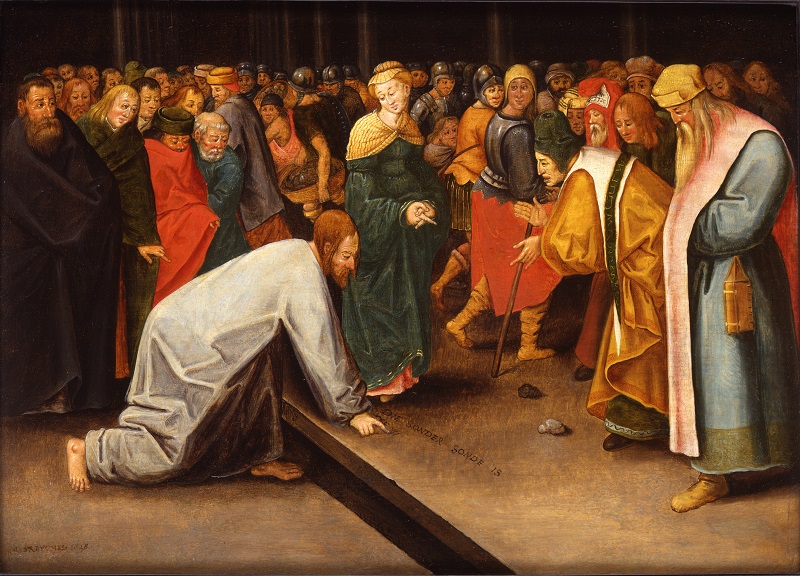Bruegel in Black and White: Three Grisailles Reunited, Courtauld Gallery | reviews, news & interviews
Bruegel in Black and White: Three Grisailles Reunited, Courtauld Gallery
Bruegel in Black and White: Three Grisailles Reunited, Courtauld Gallery
Virtuoso works by the Netherlandish master dazzle and beguile

Now that Renaissance altarpieces live for the most part in museums and not churches, our experience of them is, quite literally, flat. Once, the winged altarpieces so popular in northern Europe, comprising a central panel flanked by two moveable “doors”, would have changed appearance according to the Church calendar, the wings left closed during Lent to be opened again at Easter when the glorious colours of its central image would once again be revealed.
To create maximum theatrical effect, the reverse sides of the panels were often decorated in grisaille – as black and white painting was known until much later – images in monochrome that provided a focus for pious reflection in keeping with the sombre tone of the season.
 The dramatic impact achieved by throwing open the altarpiece at Easter to reveal the jewel-like colours within was as much an artistic as a devotional gesture. The contrast between monochrome and colour showcased the versatility of the artist and his workshop, with grisaille typically providing an opportunity for trompe-l’oeil representations of fictive stonework. This was an exercise that not only demonstrated painterly skill, but engaged with an important Renaissance debate about the superiority of painting over sculpture.
The dramatic impact achieved by throwing open the altarpiece at Easter to reveal the jewel-like colours within was as much an artistic as a devotional gesture. The contrast between monochrome and colour showcased the versatility of the artist and his workshop, with grisaille typically providing an opportunity for trompe-l’oeil representations of fictive stonework. This was an exercise that not only demonstrated painterly skill, but engaged with an important Renaissance debate about the superiority of painting over sculpture.
Three grisaille panels painted by Pieter Bruegel the Elder (c1525-1569) and now reunited for the first time at the Courtauld Gallery are significant not least because of their complete departure from this tradition. Remarkably, they seem to constitute a watershed moment: before these three oil paintings, all produced in the 1560s, grisaille was a fairly lowly genre, limited to its use as a component of altarpieces, or in preparatory works for paintings and prints.
In fact, for a long time, Bruegel’s grisailles were thought to be just that. Prints after The Death of the Virgin, c1562-65, and Christ and the Woman Taken in Adultery, 1565 (Main picture), were known long before the rediscovery of the paintings, and perhaps inevitably, the prints were thought to be the final works.
Nevertheless, the evidence that these paintings are actually autonomous is overwhelming, and part of the joy of this one-room exhibition is the way in which it underlines the value of looking seriously at pictures. The execution of The Death of the Virgin, Three Soldiers, 1568 (pictured above right), and Christ and the Woman is resolutely painterly, with space, form and volume built and modelled in glazes of black, white and shades of grey (discoloration of the varnish and ground has introduced a warm tint), making them of little use in the preparation of a linear composition.
 Markedly different from the earthy scenes of peasant life we tend to associate with Bruegel, the grisailles are highly atmospheric, contemplative works. Dispensing with colour allowed Bruegel to focus on formal relationships and above all light, not only the differing qualities of light emitted by flames, for instance, in contrast to the divine light of the Virgin, but also in the way that light affects the appearance and definition of figures and draperies. A later version of Christ and the Woman, painted in full colour, really highlights the meditative qualities of black and white, the colour providing such a distraction that it entirely dissipates the tension of the encounter between Christ and the Pharisees (pictured above left). In fact, many of the qualities that distinguish Bruegel's use of black and white would recur in the 20th century as the subject of heated debates on photography.
Markedly different from the earthy scenes of peasant life we tend to associate with Bruegel, the grisailles are highly atmospheric, contemplative works. Dispensing with colour allowed Bruegel to focus on formal relationships and above all light, not only the differing qualities of light emitted by flames, for instance, in contrast to the divine light of the Virgin, but also in the way that light affects the appearance and definition of figures and draperies. A later version of Christ and the Woman, painted in full colour, really highlights the meditative qualities of black and white, the colour providing such a distraction that it entirely dissipates the tension of the encounter between Christ and the Pharisees (pictured above left). In fact, many of the qualities that distinguish Bruegel's use of black and white would recur in the 20th century as the subject of heated debates on photography.
Executed with flair and virtuosity and painted on high-quality panels, Bruegel’s grisailles are paintings to be studied up close, pored over and revisited: everything about them distinguishes them as highly prized, rare objects.
In fact, the prints and painted copies shown alongside the grisaille paintings are testament to the esteem in which they were held, and their desirability amongst collectors in the 16th and 17th centuries. The story is that when Jan Bruegel the Elder bequeathed his father’s grisaille painting Christ and the Woman to Cardinal Federico Borromeo in Milan in 1625, the cardinal returned it to the Bruegel family, saying that it was too generous a gift. Before he returned it, however, he had a copy made by an anonymous Lombard painter, and that painting is included in the exhibition to compare with the original.
Providing some sense of just how sought after Pieter Bruegel the Elder’s work was in the period after his death is a second display in the Courtauld’s dedicated drawings gallery. Bruegel, Not Bruegel presents drawings all once considered to be autograph works by the Netherlandish master, nearly all of which have since been identified as either pastiches or deliberate forgeries. Between them these two small exhibitions not only present important but little-known works, but in their scholarly, focused approach send us down some fascinating byways in the history of connoisseurship and collecting.
rating
Share this article
The future of Arts Journalism
You can stop theartsdesk.com closing!
We urgently need financing to survive. Our fundraising drive has thus far raised £49,000 but we need to reach £100,000 or we will be forced to close. Please contribute here: https://gofund.me/c3f6033d
And if you can forward this information to anyone who might assist, we’d be grateful.

Subscribe to theartsdesk.com
Thank you for continuing to read our work on theartsdesk.com. For unlimited access to every article in its entirety, including our archive of more than 15,000 pieces, we're asking for £5 per month or £40 per year. We feel it's a very good deal, and hope you do too.
To take a subscription now simply click here.
And if you're looking for that extra gift for a friend or family member, why not treat them to a theartsdesk.com gift subscription?
more Visual arts
 'We are bowled over!' Thank you for your messages of love and support
Much-appreciated words of commendation from readers and the cultural community
'We are bowled over!' Thank you for your messages of love and support
Much-appreciated words of commendation from readers and the cultural community
![SEX MONEY RACE RELIGION [2016] by Gilbert and George. Installation shot of Gilbert & George 21ST CENTURY PICTURES Hayward Gallery](https://theartsdesk.com/sites/default/files/styles/thumbnail/public/mastimages/Gilbert%20%26%20George_%2021ST%20CENTURY%20PICTURES.%20SEX%20MONEY%20RACE%20RELIGION%20%5B2016%5D.%20Photo_%20Mark%20Blower.%20Courtesy%20of%20the%20Gilbert%20%26%20George%20and%20the%20Hayward%20Gallery._0.jpg?itok=7tVsLyR-) Gilbert & George, 21st Century Pictures, Hayward Gallery review - brash, bright and not so beautiful
The couple's coloured photomontages shout louder than ever, causing sensory overload
Gilbert & George, 21st Century Pictures, Hayward Gallery review - brash, bright and not so beautiful
The couple's coloured photomontages shout louder than ever, causing sensory overload
 Lee Miller, Tate Britain review - an extraordinary career that remains an enigma
Fashion photographer, artist or war reporter; will the real Lee Miller please step forward?
Lee Miller, Tate Britain review - an extraordinary career that remains an enigma
Fashion photographer, artist or war reporter; will the real Lee Miller please step forward?
 Kerry James Marshall: The Histories, Royal Academy review - a triumphant celebration of blackness
Room after room of glorious paintings
Kerry James Marshall: The Histories, Royal Academy review - a triumphant celebration of blackness
Room after room of glorious paintings
 Folkestone Triennial 2025 - landscape, seascape, art lovers' escape
Locally rooted festival brings home many but not all global concerns
Folkestone Triennial 2025 - landscape, seascape, art lovers' escape
Locally rooted festival brings home many but not all global concerns
 Sir Brian Clarke (1953-2025) - a personal tribute
Remembering an artist with a gift for the transcendent
Sir Brian Clarke (1953-2025) - a personal tribute
Remembering an artist with a gift for the transcendent
 Emily Kam Kngwarray, Tate Modern review - glimpses of another world
Pictures that are an affirmation of belonging
Emily Kam Kngwarray, Tate Modern review - glimpses of another world
Pictures that are an affirmation of belonging
 Kiefer / Van Gogh, Royal Academy review - a pairing of opposites
Small scale intensity meets large scale melodrama
Kiefer / Van Gogh, Royal Academy review - a pairing of opposites
Small scale intensity meets large scale melodrama
 Jenny Saville: The Anatomy of Painting, National Portrait Gallery review - a protégé losing her way
A brilliant painter in search of a worthwhile subject
Jenny Saville: The Anatomy of Painting, National Portrait Gallery review - a protégé losing her way
A brilliant painter in search of a worthwhile subject
 Abstract Erotic, Courtauld Gallery review - sculpture that is sensuous, funny and subversive
Testing the boundaries of good taste, and winning
Abstract Erotic, Courtauld Gallery review - sculpture that is sensuous, funny and subversive
Testing the boundaries of good taste, and winning
 Edward Burra, Tate Britain review - watercolour made mainstream
Social satire with a nasty bite
Edward Burra, Tate Britain review - watercolour made mainstream
Social satire with a nasty bite
 Ithell Colquhoun, Tate Britain review - revelations of a weird and wonderful world
Emanations from the unconscious
Ithell Colquhoun, Tate Britain review - revelations of a weird and wonderful world
Emanations from the unconscious

Add comment